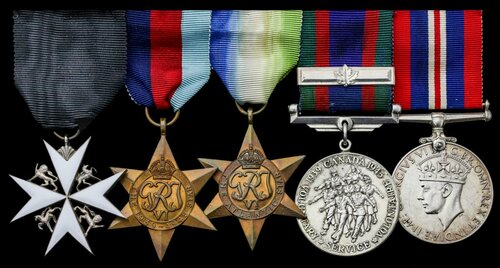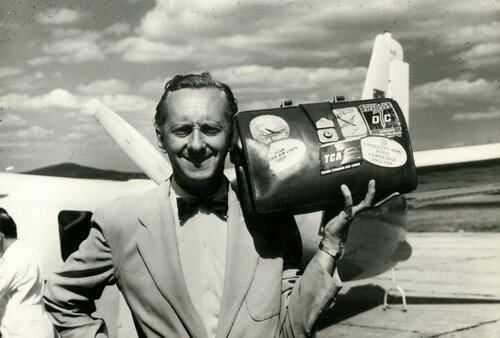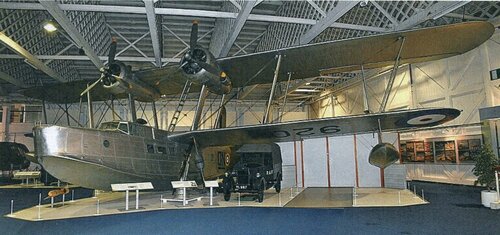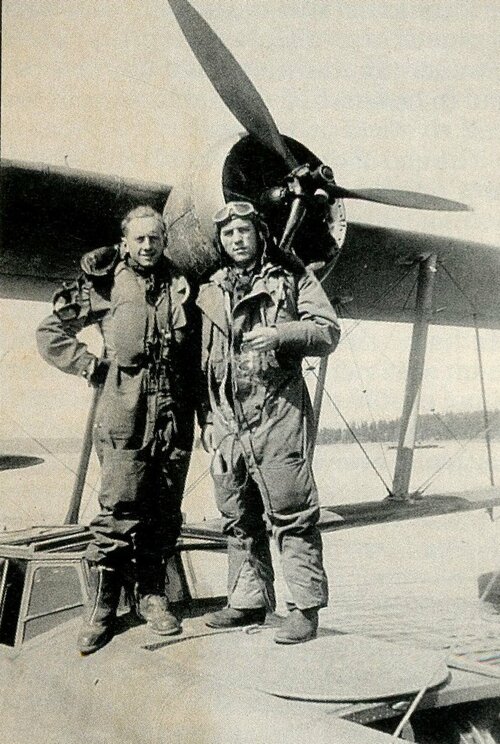Auction: 20003 - Orders, Decorations and Medals
Lot: 39
A fascinating Second World War group of five awarded to Flight Lieutenant H. H. Green, Royal Canadian Air Force, who managed to pursue two careers, as Pilot and as the Star of film, radio and television, including the hugely popular entertainment show Opportunity Knocks, which brought joy and laughter to audiences of up to 18 million and kicked-started the careers of many well-known personalities today
Having survived three extremely close-calls involving mechanical failures over the North Atlantic and an encounter with two Russian MiG Jets who fired upon him in the 'Berlin Corridor', Green nevertheless retained a passion for aviation - and flying boats in particular - his entire life. He later found himself on the front pages of the British Press when it was disclosed that he was the father of television personality Paula Yates
The Order of St. John of Jerusalem, Officer's (Brother's) Breast Badge, silver and enamel, with heraldic beasts in angles of cross; 1939-45 Star; Atlantic Star; Canadian Volunteer Service Medal, with overseas clasp; War Medal 1939-45, silver issue, mounted as worn, very fine and better (5)
Hugh Hughes 'Hughie' Green was born on 2 February 1920 at Marylebone, London, the son Hugh Aitchison Green of Montreal, Quebec, a former Major in the Canadian Militia who made a small fortune supplying tinned fish to the Allied forces during the Great War and held trademarks issued by the U.S. Patent Office associated with the production of 'smoked haddie' (herrings). Educated at Arnold House Preparatory School in St. John's Wood, Green witnessed the gradual decline of the family business and instead, with his father's encouragement, took his first tentative steps into show business via his godfather, Harry Tate, famous at that time as a music hall entertainer. In fact his first stage appearance was heavy with aviation overtones and couldn't be a more appropriate introduction for a boy who would later be endowed with an ageless joie de vivre for stage and sky; employed hidden in the nose of an aeroplane sketch prop, it was Hughie's job to turn the propeller at a realistic speed!
From this deeply anonymous beginning, his career steadily took hold until in 1933, the Hughie Green Gang made its broadcast debut on the BBC, written, produced and directed by its 13-year-old star. He was the first child to be heard and not seen in Lord Reith's sacred British Broadcasting Corporation, and the success of the show over the airwaves led to a highly acclaimed tour of the U.K. and Canada. In 1935, Green took the starring role in the feature film Midshipman Easy, co-starring Margaret Lockwood, then travelled 'across the pond' to Hollywood where he appeared in the film Tom Brown's School Days. Taking the role of Walker Brooke at Rugby School, Green's performance was well received in this coming-of-age drama about a school plagued with bullies, the most famous of all being 'Flashman', played by a young Billy Halop. Green went on to act in Master of Lassie and then appeared in the evenings at The Coconut Grove with a cabaret act. It was around this time that Hughie fathered his first child at the age of 17 with Vera Hands, a Birmingham usherette.
A Passion for Flight
Hughie's earliest experience of flying had been from a field alongside Edinburgh Zoo when he was about 8 years of age. Having taken private flying lessons, he flew his first solo from Doncaster Aerodrome in a B.A. Swallow on 14 June 1939. Ten weeks later, whilst on tour at Inverness, Green hired a small aeroplane and took a 'jolly' over the dark waters of Loch Ness, but almost as soon as he landed all pleasure flying in Britain was forbidden following the German invasion of Poland and the consequent imminence of war; he may even have made the last purely private flight in the country for over five years!
Initially declined by the R.A.F., Hughie returned to his father's home in Canada with the intention of joining up over there. After 'cooling his heels' in Montreal for weeks without result, he went south to California and notched up the flying hours in Piper Cubs. In May 1941, No. 104851 Aircraftman 2nd Class H. Green was finally called to serve with the Royal Canadian Air Force, being trained as a Link Trainer instructor - one of the earliest types of flight simulators. Promoted Sergeant Instructor at Windsor Mills, Quebec, Hughie regarded the time spent on the 'blue box' perfecting the fundamentals of instrument flight as invaluable:
'I learned then how to fly… and to stay alive!'
A Brief Interlude
Next, quite suddenly, Green was sent back to showbusiness and a principal role in a patriotic drama by Guy Bolton titled Golden Wings. The story was based upon the R.A.F.'s war operations, and was intended to generate goodwill towards Britain and a propaganda advantage in the U.S.A. after the fashion of Mrs Miniver; unfortunately for Hughie the Broadway opening precisely coincided with the Japanese attack on Pearl Harbour, which concentrated American thinking overnight on a war of their own; just days later he was back in Canada on the eve of his R.C.A.F. flight training, which culminated in the award of his 'Wings' at Brantford, Ontario, on 19 November 1942.
First Posting
Sent to an Operational Training Unit at Patricia Bay, British Colombia, Green initiated a long and enduring passion for flying boats. Here he learned the arts of an air mariner in the beautiful and elegant Supermarine Stranraer biplanes based there, and actually flew the one now preserved at the R.A.F. Museum, Hendon (Aeroplane Monthly, October 1996, refers). Upon first seeing the aircraft, his instructor and friend, Flight Lieutenant Bill Brooks, is noted to have said to Hughie:
'We could play tunes on its wires - or fly it' (Hughie Green, Flying Boat Captain, refers).
An effective trainer, Green learned air and water handling, take-offs and landings by day and night. Surprisingly, upon being posted to No. 117 Squadron, R.C.A.F., Green found that, whilst the Catalina was a much more capable aeroplane, the second-line service Stranraer aircraft had far superior water handling.
On 9 October 1943, flying Consolidated 'Consa' Catalina 9709 out of North Sydney, Green nearly lost his life on his very first job looking for a submarine spotted the day before. His log book simply notes 'A. S. Sweep', but having conducted an unsuccessful search for the U-Boat he headed back to base, only to be advised that it was closed by swirling snow and that he should divert to Argentia. Unbeknown to Green and his new crew, certain leads in the Catalina's radar had been wrongly connected, and the starboard turn which he made on its indications in fact took him out into the expanse of the North Atlantic:
'After a while he became increasingly worried and, acting contrary to R.C.A.F. instructions in such circumstances, he reduced his airspeed and began to circle. The thick cloud made star bearings impossible, but by great good fortune they managed to tune into a radio signal from a station on the air for the first time and making test transmissions. This shepherded them into Argentina, by then itself weather-threatened, and they landed with the merest splash of fuel in the tanks after 19 hours (sic) in the air' (The Sky's the Limit, Aeroplane Monthly, refers).
According to Green's log book, the flight totalled 11.20hrs, but whatever the case, it had been a fortunate escape. Catalina 9709 was sent for repairs to its radar and wasn't flown again by Green until 31 October 1943. In the meantime, Green conducted a series of Naval co-operation flights aboard Catalina 213, including a search for a Royal Naval swordfish aircraft forced down in the North Atlantic on 23 October 1943.
Meet our Russian Allies!
At the end of 1943, No. 117 Squadron were moved to Ceylon. Rather than remain with his unit, Flight Lieutenant Green transferred with his best friend, Flight Lieutenant Arthur 'Art' P. Teulon Jr. (guest on This is Your Life - see next Lot), to R.A.F. Ferry Command at Dorval, where he flew Liberator aircraft backwards and forwards across the North Atlantic. He transferred military commanders, statesmen and industrialists to South America, Africa and India, and somewhat uniquely, was placed in Command of R.A.F. Station Boucherville, which was equipped with the great bluff Consolidated Coronado flying boats. This is confirmed by a letter from No. 45 Group, R.A.F., posted into Green's log book, noting, 'you will therefore be responsible for the operation of aircraft in and out of the flying boat base as well as the proper and efficient running of the Unit.'
In the summer of 1944, Green had his first meeting with the Russians. A few months previously President Roosevelt had agreed to sell 60 Catalina flying boats, reputedly for just $3 per aircraft, and, having been 'trained' by the U.S. Navy, their somewhat green Russian pilots requested help to take them home:
'In addition to the ferry crew, each aircraft carried a party of apparently uniformly enormous Russians who had no English skills whatsoever, and whose flying skills were somewhat lacking in refinement. In addition, the Russian aircraft had been constructed in U.S. Navy yards and, for some obscure reason, had a modified hull-step design. Although this conferred an additional 7mph to the aircraft's modest maximum speed, it also necessitated very flat touchdowns if severe porpoising was to be avoided.
Such finesse was generally beyond the enthusiastic Russians, one of whom achieved a multiple landing of such thunderous duration that the aircraft had to be beached to enable most of the hull rivets to be replaced' (Aeroplane Monthly, refers).
In an interview conducted with the Aircraft Enthusiast's Group, it was noted:
'Hughie regards the six flights he did with them [the Russians] as his most dangerous moments of the war.'
Looking to the Future: Aviation or Entertainment?
The end of the war found Hughie back in Canada, contemplating the best way to return to show business whilst maintaining his hard-won skills as a pilot; he knew the world of entertainment was notoriously fickle, and aviation could provide him with both absorbing interest and some kind of financial return if he ever needed it. An early show tour proved just this point, leaving him wiser but not much richer; he took work with British Aviation Services and made a few pounds delivering Dakota aircraft to Belgium and Norway and a battle-weary C-47 back to Canada. The latter brought a second close-shave:
'On this last occasion, and with two "passengers" aboard, they were held up at Reykjavik by appalling North Atlantic weather for three days before being cleared on to Greenland. In the midst of freezing cloud, and some hours after leaving Iceland, the port engine began to show serious signs of malfunction and they feathered it. Later, struggling to maintain height on one engine, they decided to lighten the Dakota by throwing everything possible into the seething ocean. One passenger declined to offer his briefcase to the jetsam, and after some haggling this refusal was reluctantly accepted' (Aeroplane Monthly, refers).
Some three hours later, Green and his petrified passengers sighted the coastline of Greenland at little more than 200 feet above the waves. Upon landing, the passenger with the briefcase identified himself as Graham Frieze-Green, the son of the inventor of the motion picture camera. The case had contained all that remained of the historical documents about the invention, and he was on his way to Hollywood, where a film about his father was to be made; needless to say, Hughie did not get a part in the picture, but was left with a lasting aversion to the prospect of transoceanic flights in twin-engined aircraft.
Delivery Pilot and Aviation Advisor
The ready availability for sale of fleets of surplus military aircraft, coupled with a burgeoning output of smaller executive and corporate aircraft types, led to a steady demand for competent delivery pilots in the early post-war years. In the late 1940s, Green tackled various aviation projects with Tony Couloucoundis, scion of the Greek shipping family, and in 1953 acted for a Greek syndicate putting up a million dollars as a demonstration of good faith to cover the continued test flying of large flying boats. In Green's own words, 'big boats' would be ideal users of nuclear power, operating hazard-free over the oceans, landing or taking off well clear of cities on no-cost runways of whatever length may be required!'
Needless to say, despite the hugely forward thinking motivations, not least the depletion of fossil fuel reserves over time, the reality of creating a profitable business along these lines was a long way off.
Next came the strange case of the Sealand, an attractive but otherwise undistinguished small 'executive' amphibian designed and built by Short Brothers. Underpowered and under ranged, the Sealand had been well-short of a commercial success despite a series of extensive demonstration flights throughout Canada, the U.S.A. and South America. Hughie was somewhat surprised, therefore, to be asked by the London representative of a very rich shipowner to find a Short Sealand. Not knowing who the customer was, Green suggested that a Grumman Mallard would be a far better bet if the purchaser could "afford American money" in those far-off days of dollar supremacy. The laugh was on Green when he was informed that the prospective owner was Aristotle Onassis. Furthermore, when the suggestion of the Mallard as a better alternative was put to Onassis, the somewhat disgruntled tycoon said:
'Please tell Captain Green that it's my money which is buying the aeroplane, not his!"
Fortunately a Sealand was forlornly available in Canada, and work was put in hand to fit it with new fuel tanks before a somewhat apprehensive Green flew it back across the Atlantic to Belfast, then on to Nice. Upon arrival, the new owners, Aristotle Onassis and Stavros Niarchos, requested a 'quick flip around the Bay,' before the latter was flown to Newcastle in order to launch a tanker the next day!
Third time Lucky…
During the 1960s, Hughie was appointed to handle European sales of the Grumman Gulfstream Atlantic Aviation jet having fostered a long-term friendship with Henry DuPont, the elderly head of the family which controlled General Motors. Gulfstream's were sold to Shell, Mercedes Benz, and to Johnny Agnelli of Fiat. A sale was even achieved to the Prime Minister of Nigeria. Green later became the first pilot to cross the Atlantic in a Cessna 336, and subsequently used the aircraft to tour the U.K. with holiday-camp tycoon Billy Butlin. It was said that 'Billy used the 336 in just the same way as a company limousine, but he saved himself hours in the process' (Aeroplane Monthly, refers).
In 1963, Green took to the controls of a 'borrowed' Cessna 310 and proceeded to fly down the air corridor which provided access to Berlin. This peaceful journey to present a couple of shows to British forces in the City suddenly developed into a frightening incident when he was 'buzzed' by two increasingly aggressive Russian MiG fighters, one of which fired a warning burst of shots and indicated that he should land; as luck and quick thinking would have it, he was able to evade his pursuers by diving into cloud, and soon afterwards he sighted the runway lights of Gatow airfield.
The event created quite a headache for the British authorities; his flight had been cleared by the British, French and Americans, but the former had apparently failed to inform the Soviets, whose permission was also required before any aircraft could be flown into Berlin. Green later received a small compensatory payment from Whitehall, but more important to him was the fact that his reputation as a highly responsible pilot was not impugned.
A Return to Mainstream Popularity
In 1955, Green became a household name with the ITV quiz show Double Your Money, which had actually originated some years earlier on Radio Luxembourg. He went on to present the show in Moscow in 1966, but because the Communist Party would not allow money as a prize, the top prize was a television set (Television's Greatest Hits, refers).
However, by far Green's most successful show format was the long-running talent show Opportunity Knocks. Started as a U.K.-wide touring show for radio, it transferred to television and became a massive hit. It is credited with beginning the show business careers of Les Dawson, Lena Zavaroni, Pam Ayres and Mary Hopkin, and Hughie was well-known for flying the panel of judges between audition venues all over Britain in his small Cessna aircraft. Similar formats receive prime-time television billing today, under the titles of 'Britain's Got Talent' and 'The X Factor'.
Opportunity Knocks was a ratings hit that attracted up to 18 million viewers weekly. It was finally axed in 1978 after Green was disciplined by Thames Television for making political comments, and was replaced by the family-friendly youth orientated comedy The Kenny Everett Video Show which attracted 14 million viewers.
A Complex Personal Life
Having met and married Montreal society beauty Claire Wilson, Green became a father for a second and third time. Living with his wife, son and daughter, in a fifth floor flat in Baker Street, London, it was said that Green's numerous affairs and self-obsession - including taking luxury holidays and often spending Christmas alone - led to a 'highly dysfunctional' family life. The couple separated in 1961 and filed for divorce in March 1975, once it was discovered that Green had started an affair with Gwen Claremont. Later that year, Claire married actor David Langton of Upstairs, Downstairs, fame.
Following further affairs and issues regarding drinking, it was later exposed in The News of the World that Green was the biological father of TV presenter Paula Yates, a fact she first learned when the story was published in the newspaper. Through his daughter Paula, Green had four granddaughters whom he never knew: Fifi, Peaches and Pixie Geldof, and Heavenly Hiraani Tiger Lily Hutchence who was legally adopted by Bob Geldof in 2007.
Green survived a near fatal car accident near Reading in the 1980s which affected him greatly. A failed court case against the New Zealand Broadcasting Corporation over a copyright infringement cost him £250,000 in 1989 ((Hughie) Green V Broadcasting Corporation of New Zealand, Refers), equivalent to more than £600,000 in today's money (The Bank of England inflation calculator, refers). As a result, Green stepped back from the public gaze and spent his final years away from the media, residing at his Baker Street apartment. Here he lived a simpler, quieter life, devoting his spare time to a miniature railway which took up a room in his home. Diagnosed with oesophageal cancer and admitted to the Royal Marsden Hospital, Chelsea, he died on 3 May 1997. His memorial at Golders Green Crematorium reads:
'You were the star that made opportunity knock. You will never be forgotten.'
In 1965, Green released his autobiography titled 'Opportunity Knocked' to positive reviews:
'It is brimful with lively anecdote and the sort of background stories that really reveal what makes Hughie Green tick.'
Further publications linked to his family include Paula Yates, The Autobigraphy, and Big Girls Don't Cry - The Wild and Wicked World of Paula Yates' Mother. In the light of the death in 2000 of his daughter Paula Yates, Green's son Christopher, now a Canadian resident, wrote the autobiographical perspective, Hughie and Paula: The Tangled Lives of Hughie Green and Paula Yates.
To be sold with the following research and ephemera:
(i) The original Royal Canadian Air Force Pilot's Flying Log Book to P/O. H. H. Green. This comprehensive log book represents the full Second World War service of Green, commencing with Elementary Training at No. 7 E.F.T.S. on 8 June 1942, his first flight being a 'Familiarisation' with Sergeant Jones aboard Tiger Moth 3981 the following day. Rated 'above average' as a pupil pilot on 19 November 1942, the well-annotated log book gives full details of approximately 460 flights, noting aircraft flown, postings and including a number of small 'snapshot' photographs of Green and his crews at the time when he was on Flying Boats.
Following a couple of blank pages, the log details his flights for British Aviation Service and a host of other private employers from 25 February 1946-20 September 1955, incorporating a further 520 flights in Auster, Proctor, Bonanza, C-47, DC-3, Gemmini, Sealand, Piaggio, Navion, Lodestar, Beechcraft, and A-26 aircraft. According to a label affixed to the inside front cover, 'All the pages of this original RCAF Pilot's Flying Log Book for Flt. Lt. H. H. 'Hughie' Green was transferred in 1997 onto microfilm & is held in the RAF Museum, Hendon, London.'
(ii) Original Royal Canadian Air Force Special Reserve Commission Certificate, dated 20 November 1942; Release Certificate, noting 'J20981 Flight Lieutenant Hugh Hughes Green' served in the R.C.A.F. from 22 May, 1941, being Honourably Released and transferred to the General Section of the Reserve, Class 'E', on 30 October 1945; Application for Campaign Awards document; Letter from the Department of Transport, Montreal, dated 2 November 1955, which states his application for an Airline Transport Pilot License is accepted; Rolls Royce Ltd. Aero-Engine School Certificate to 'H. Green', certifying him as having satisfactorily completed a course of instruction in the Construction, Operation and Flight Handling of Dart 529 Engines, dated 6 January 1961.
(iii) Original Birth Certificate and Marriage Certificate, dated 26 September 1942; Certificate of Canadian Citizenship, dated 14 May 1951; Separation Agreement, dated 7 September 1962; Canada Passport, issued 2 July 1992, together with two large files of copied research detailing his private and professional life, inclusive of a small number of original photographs in later life and copied images whilst serving as Pilot.
(iv) An original copy of Aeroplane Monthly, dated October 1996, which bears an excellent article titled 'Hughie Green: The Sky's the Limit'.
(v) Six original hardback books relating to the personal and professional life of Green:
Hughie Green: Opportunity Knocked, published 1965, with inscription to inside cover, 'thank you for the many knocks you've saved me' (signature indistinct); High Fliers: 30 Reminiscences to Celebrate the 75th Anniversary of the R.A.F. (bearing the original signature of Squadron Leader Kenneth Wolstenholme, D.F.C. & Bar, R.A.F.V.R. - later famous for broadcasting the BBC Radio Commentary for the 1966 Soccer World Cup Final); Ocean Bridge. The History of R.A.F. Ferry Command; Hughie and Paula, The Tangled Lives of Hughie Green and Paula Yates; Big Girls Don't Cry; Paula Yates, The Autobiography.
Subject to 20% VAT on Buyer’s Premium. For more information please view Terms and Conditions for Buyers.
Sold for
£1,800
Starting price
£1800

















